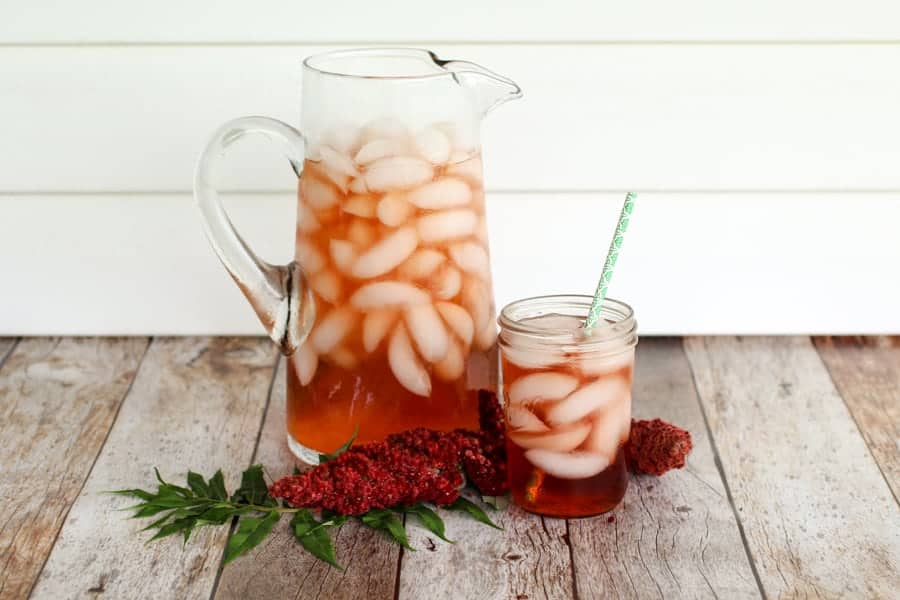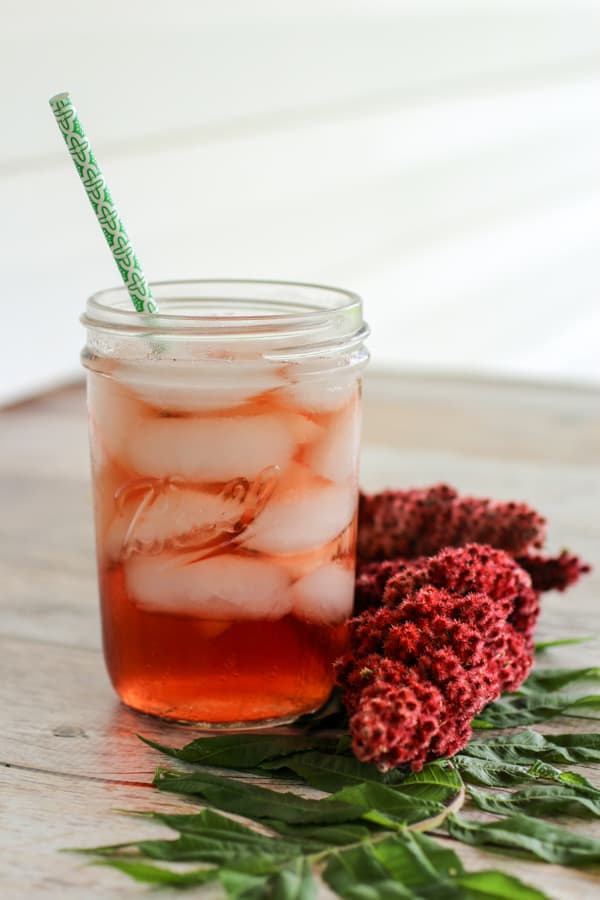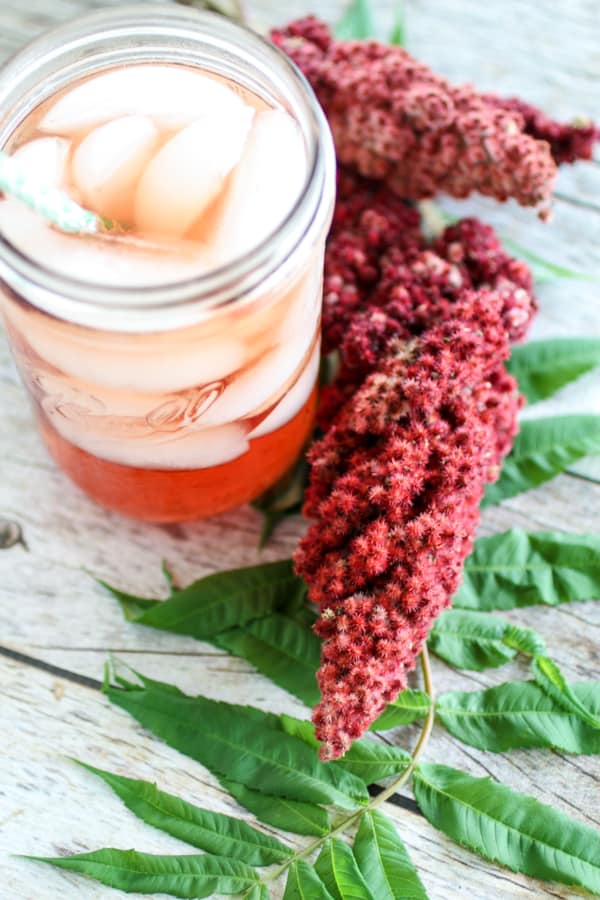Sumac-ade; a Natural Alternative to Kool-aid


Sumac leaves and berries are classified as astringent and cooling. Certain Native American and Canadian Indian tribes used sumac to treat bladder, digestive, reproductive, and respiratory ailments; infections; injuries; stomachaches; arrow wounds; and more. The Chippewa Indians of North America made a decoction of sumac flowers to treat gas, indigestion, and other digestive upsets. The Iroquois used sumac as a laxative, diuretic, expectorant, liver aid, and in countless other applications. The powdered bark and dried berries were allegedly combined with tobacco and smoked during peace pipe ceremonies. The inner bark was also used to treat hemorrhoids.
The Pioneers used the berries to calm fevers and they steeped and strained the berries and and added honey to stop a mild cough. They also turned them into wine! Others used the root to produce an emetic tea to induce vomiting. The bark was used as a dye for rags, paint and more. The leaves are the first to change in the fall, the color is red.
The sumac plant typically belongs to sub-tropical and temperate region. It grows in Mediterranian countries, North Africa, South Europe, Afghanistan and Iran. It is a popular condiment used as souring agent. This reddish purple sumac spice power is very common in Middle Eastern and Arabic cooking. Sumac adds a tangy lemony taste to food. It is used to marinate meat, garnish hummus, salad. In Iran, sumac is added to rice or kebab. The popular spice mixture za’atar contains sumac.
Varieties that grow in North America are Smooth Sumac and Staghorn Sumac, are most commonly used to make tangy cool drink known as sumac-ade or Indian lemonade or rhus juice. Sumacade is made by soaking sumac berries (drupes) in cool water, straining the liquid and adding sweetener, it’s a taste similar to lemonade or lightly sweetened tropical punch/cherry koolaid.
Everyone we’ve had try it agrees that it’s a yummy summer treat, that’s chock-full of healthy vitamin c!
Sumac berry clusters are ready to be picked in late summer (august) when they are deep reddish/burgundy color. It’s best to harvest them after an few dry days, the sumac flavor will be diluted following a rain so you don’t want to pick wet sumac.
Pinch off a tiny berry and taste the amazing tart flavor, I think it tastes like a mix of red raspberries & lemon. The berry clusters will break off easily or you can use clippers to cut them off.
Don’t forget to save some fresh sumac for winter. Simply store your fresh sumac berry clusters in an open brown paper bag in a cool/dark place in your house (we keep ours in a closet) they will naturally dry. You can then use the whole, dried berry clusters to make sumacade later or grind them into a powder to use as a seasoning.

Ingredients
- Fresh Sumac Berries drupes
- Water, filtered
- stevia or other sweetener, to taste
Instructions
- Place sumac berries in cool/room temperature water - I recommend 1 large berry cluster per 2 cups of water at a minimum. The more sumac you use the less time it will take to create flavorful sumac-ade
- Crush or break apart the berry clusters in the water
- Allow to soak for a few hours to a few days, depending on how much sumac you used and how strong you'd like your sumacade
- Strain your extract through cheesecloth or similar fine mesh fabric
- Sweeten to taste
- Serve over ice for a refreshing beverage!
Notes
Also, sumac has anti microbial properties. A study published in International Journal of Food Microbiology suggested sumac’s antimicrobial activity that can combat Salmonella bacteria. Water mixed with sumac extract can be used to treating vegetables and fruits and get rid of bacteria on them. Anti microbial properties of sumac were attributed to presence of methyl gallic acid, gallic acid and other compounds in a study published in Journal of Ethnopharmacology.
Have you ever had Sumac-ade? Are you going to try some yourself?









Hello! Sorry in advance if this is a silly question. If I’m going to leave this to steep for a couple of days, should it be refrigerated? Thank you in advance for your help!
I have left mine steep I refrigerated in a cool place and it’s worked fine.
fyi in case you haven’t already seen this, which refers to this blog posting: https://www.eater.com/2022/2/28/22947543/what-is-sumac-how-to-use-cooking-recipes
How would I modify this using ground Sumac spice?
I’m sorry I have no idea, I only use fresh. But if it’s too strong just add more water to dilute. Too weak steep longer or add more.
Absolutely delightful knowledge. I use sumac in my homemade salad dressing and was looking for other ways to use it. I absolutely love this idea and can’t wait to try it. Thank You.
Great recipe for making a poultice for my hemorrhoids!
This article was wonderful to run across!
As children, we were given sumac to prevent bed wetting, and it worked.
Recently I was telling a group about sumac and was surprised at the number who had never heard of it or thought erroneously that it was poisonous.
Sumac-ade is way better than kool-aid in my opinion.
We made some with Badia Sumac and it is delicious! we also added a tiny bit of Cayenne pepper, Amazing!
Even though Sumac is in the same family as cashews, mangoes, and poison ivy, I’m pretty sure some one that has had a reaction to those things generally doesn’t have to worry. Sumac (the non-poison type) doesn’t contain urushiol, the chemical that causes the allergic reaction.
I’ve been doing this since I was 5 with my dad, what you must really look for is in late July/Early August the sumac berries turn white with a sugary like paste, that’s when you harvest to make a Kool-aid. It is when vitamin C is most potent.
Something is not adding up.
The sumac that grows in NY and CT looks like the photos, but is not at all what you describe.
The “berries” are not succulent, but rather are hairy blobs with absolutely no taste, nothing to bite into, no juice at all (more like small hairballs).
I have been soaking 2 clusters in 8 cups of water for 2 days now with no result.
The water has turned a rosy pink, but has no taste.
I harvested the clusters 2 days ago, on Aug 30.
Please help.
Hey Jody – Did I say they were ‘succulent’ berries or that there was a distinct fruit to BITE into? Yes they are dry very seedy berries. Yes they can be bland when harvested after periods of rain, hence why I specify to pick after dry spell, the flavors concentrate. One last thing, your water to sumac ratio seems very light as well… I suggest 1 large cluster to 2 cups of water, you essentially just want to cover the sumac with water.. they are not a potent as a tea bag.
We use our taste buds to determine when the best time to pick is, we’ve had a very wet summer here in PA and the flavors are still slightly diluted. The longer a hot, dry spell is the more intense the flavor will be.
Because sumac powder is disgusting and because people talk about this “lemonade” being good, I put a bit of sumac powder into my hot green tea. After several sips of this while hit and directly after a drink of it, I felt like was definitely going to vomit without the time to run to the bathroom (up two floors while in a house). This lasted 5 minutes and then stopped, but having an extremely nontoxic diet and cleaning usage, poisinings usually do little damage to me in comparison to others. Does anyone have more information about this?
Hey Raven – sorry about your experience. Sumac isn’t disgusting, it tastes like lemon. We pick it wild and use it often. I’d suggest looking into the brand of powder that you used for additives and cross contamination.
I know for freshly harvested sumac berries you are not supposed to boil them. Maybe same with the powder? Probably best to drink cold/room temp.
we don’t boil ours, we want to retain the maximum nutrition.
I was given a pack of sumac berry powder for Christmas. How much would you suggest I use to make this lemonade?
Melinda – What a great gift! I honestly don’t know… I wouldn’t worry much about it since if it’s too strong you can just dilute it with water to make it to suit your taste…
Hayley
I love the foraging tips. It’s amazing what our land has to offer if we just know what we’re looking for 🙂 I’m so ready to give this a try!
After trying the Sumac-ade, I noticed that I woke up a few times during the night with cotton mouth. I’m just wondering if anyone else had experienced the same effect.
This is so great!! I just tried my first glass! And my 90 year old mother tried it and liked it too! I will try it a bit stronger the next time! Thanks for the great recipe!